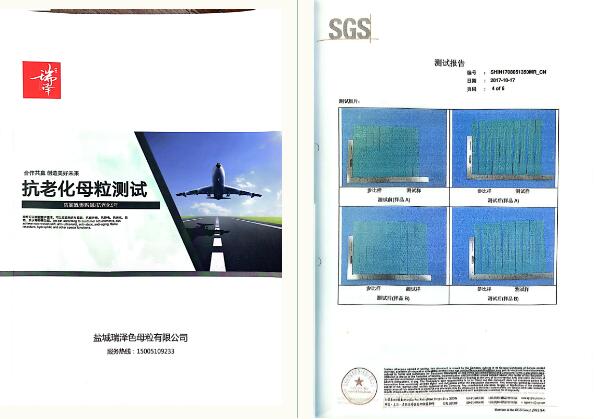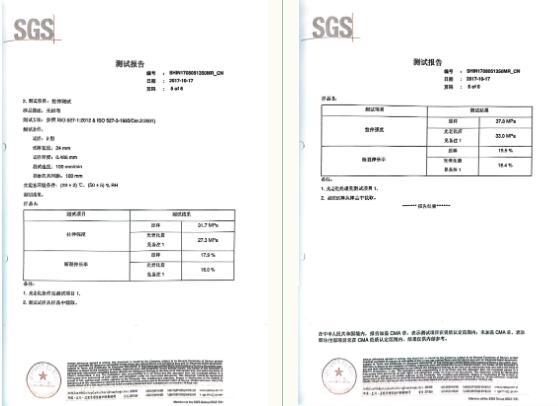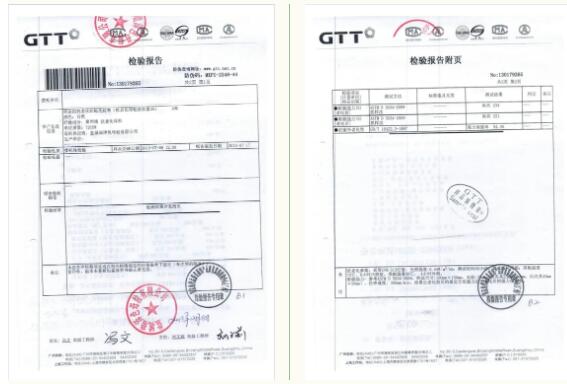PP installation Report
Test methods and precautions for color fastness of textiles to light
Yancheng Ruize color masterbatch Co., LTD
The color fastness of textiles to light refers to the degree of fading caused by the exposure to light during the use or processing of textiles.
Several common testing methods for color fastness of textiles to light
Textiles are usually exposed to sunlight when they are used. The light will destroy the dye on the product, and the result is the well-known fading, usually becoming whiter or darker, at this time the degree of fading of the textile is the color fastness to light, which is an important indicator of textile performance.
Today, we start with the detection method of textile color fastness to light, and then discuss the matters that need attention in the detection process.
At present, there are many kinds of testing methods for light fastness standards in the world, and the color fastness series standards formulated by the International Organization for Standardization (ISO) and the American Association of Textile Chemists and Printmakers (AATCC) are the most authoritative. The color fastness method of textiles used in China is GB/T series, which is equivalent to ISO series standards or slightly modified on ISO series standards, so the difference between the two is small. The standards formulated by AATCC are mainly applicable to the US market, and are quite different from the ISO series standards mainly in the EU market and the GB series standards mainly in the Chinese market [2]. This paper focuses on the main criteria of these three markets.
European market
The main standard for the European market is ISO 105-B02:2014, which applies to all types of coloured and white textiles. The test principle is to expose the sample to a set of standard blue wool fabrics under prescribed conditions under artificial light sources. The color fastness was evaluated by the color change between the sample and the standard blue wool. For white (bleached or fluorescently brightened) textiles, the change in whiteness of the sample is compared with the change in color of standard blue wool. The standard material usually used in the European market is blue wool standard sample 1-8, and the light resistance of each high grade of wool is about twice that of the previous grade. The detection equipment is air cooled xenon arc lamp equipment [3]. Humidity control sample is red cotton dyed with azo dye.
Domestic market
Our textile testing industry was mostly based on the export of European and American markets, with the development of economic level, more and more domestic brands on the international stage, quality awareness is becoming stronger and stronger, textile testing industry is also more important to the national standard market.
At present, the main light fastness standard in the domestic market is GB/T 8427-2008, which is modified on the basis of ISO 105-B02:1994, so the difference between the two is small, and the scope of application, test principle, test conditions, test equipment and specific test methods are similar [4].
American market
The color fastness to light in the US market is mainly AATCC 16.3-2012; option3 is mainly used to determine the color fastness to light of textile materials. Dyes and finishing agents suitable for textile materials and for dyeing and treating textile materials. Its test principle is similar to the method used in the European market, which is to expose the textile material to be tested with the selected AATCC blue wool standard sample under standard light source and specified conditions, and use the AATCC gray card or color meter to evaluate the color change between the illuminated and unilluminated part of the sample. The blue wool standard used by AATCC is L2-L9, and each higher grade of wool is about twice as light fast as the previous grade. The equipment selected for this standard is the water-cooled xenon arc lamp equipment. The test conditions are different from the European market, its blackboard temperature is (63±1) ℃; The temperature in the box is (43±2) ℃; The relative humidity in the box is (30±5) %. The equivalent light exposure of AATCC fading unit and AATCC blue wool standard sample is shown in Table 3 (one AFU refers to 1/20 of the exposure energy required for AATCC blue wool standard sample L4 to reach color-changing gray card level 4 or CIELAB value of 1.7±0.3) [5].
Table 3 Light exposure equivalent to AATCC fading unit and AATCC blue wool standard sample
a color-changing CIELAB value of 1.7±0.3 or AATCC color-changing gray card level 4.
b Measured by experimental method, other values are calculated.
AATCC uses blue wool standard sample to control test conditions. L4 AATCC blue wool standard sample is exposed to 20±2 hours of continuous exposure under specified temperature, humidity and irradiance conditions, and its CIELAB value should be within the range required by the certificate attached to this batch of blue wool standard sample.
The test method is to expose the sample to the sun at the same time as the corresponding AATCC blue wool standard sample until the degree of fading of the blue wool standard sample is equivalent to the color-changing gray card grade 4.
Precautions for color fastness test of textiles to light
Step 1 Sample
The color fastness to light sampling requirements include all colors, and because the plate is pressed during the test, ensure that all colors can be illuminated. The covering plate shall be in close contact with the exposed part of the sample and the blue wool standard sample, but shall not be pressed too tightly. To ensure that the size of the sample to be tested meets the standard, the sample to be tested and the wool should be the same shape and size to avoid errors in grading due to different areas. Some of the pile direction of the pile fabric is uncertain, or the structure may make the evaluation of small areas difficult, in this case, it should be appropriate to increase its exposure area.
2. Operation process
(1) Equipment
Ensure that the equipment meets the test conditions specified in the standard, strictly follow the relevant operation process, and regularly monitor the effective operation of the equipment with red cotton or blue wool standard samples. Continuity of testing should also be ensured during testing.
(2) Determination of end point
Among the above several test methods, the end point is judged most by the wool, and some are judged by the sample itself or by the reference sample, so the operator is required to know the end point determination rules of each method, and to check repeatedly during the experiment, not to take more or less photos.
3. Rating
At present, the color fastness rating method used in textile testing industry is mainly visual inspection, which requires the rating personnel to have a certain technical level. Usually to develop a good rating habits, in strict accordance with the standard requirements to operate. For some complex samples, on the basis of one person's rating, others can be asked to re-evaluate to ensure the accuracy of the results [6]. In order to reduce the differences in vision among raters, it is necessary to regularly compare the differences in vision to reduce the losses caused by the differences in vision to enterprises and customers [7].
The color fastness of textile to light is a common item in the color fastness test of textile, and it is also an important index to measure the properties of textile. Therefore, in order to ensure the objective and accurate detection, the detection must be strictly implemented in accordance with the relevant standards. This requires inspectors to have a full grasp and understanding of the various standards, while paying attention to the details of the testing process.
How to ensure the color fastness of textiles to light
Some customers ask: Can the color masterbatch color guarantee that the color does not change for two years?
Many customers are really concerned about this issue, and what I want to say today is that this issue is indeed related to the masterbatch, but it is not completely controlled by the masterbatch. The key is that polypropylene fiber to anti-aging, can after two years of exposure to the sun to achieve strength and elongation index to maintain more than 90%? To ensure color fastness, the aging resistance and ultraviolet resistance of the fiber should reach 2 years.
There are testing standards for color fastness, and it is better to talk to customers according to several levels of testing standards, rather than guarantee how many years? Powder polypropylene fiber, summer exposure for 3 months is completely powdered, how to ensure the color fastness? Even if the polypropylene fiber without anti-aging masterbatch is exposed to sunlight for half a year, the fiber attenuation is more than 70%, and the color fastness is certainly not reliable.
Therefore, when customers require a color fastness guarantee for two years, they must first consider that effective anti-aging masterbatch with excellent performance must be added in the production process of fiber or non-woven fabrics, otherwise the color fastness of the product is a tree without roots and water without source.
Reiser anti-aging test report




Ruze anti-aging masterbatch is the earliest through the United States AATCC test and certification products, has been widely used in polypropylene carpet fiber, T-shirt fiber, geotextile fiber and a variety of special non-woven fabrics, excellent quality and reliability. Welcome to have anti-aging needs of the enterprise enquiry.
References:
[1] ZHANG Huanhuan, Li Ying, Chen Liang, Zhou Wei, Tang Ying. Research on the difference of color fastness test standards of textile [J], Textile Science and Technology Progress, 2017 (7).
[2] Zhou Wei, Huang Yijing. Research on the difference of color fastness testing standards of textiles [J], China Fiber Inspection, 2012 (14).
[3]Textiles - Tests for colour fastness - Part B02: Colour fastness to artificial light: Xenon arc fading lamp test: ISO 105-B02:2014 [S].
[4] Color fastness test of textiles Color fastness to artificial light: xenon arc: GB/T 8427-2008[S].
[5]Colorfastness to Light: Xenon -- Arc: AATCC 16.3-2014[S].
[6] Han Renquan, Yang Guowei. Textile color fastness detection methods and attention to detail [J], Commodities and Quality, 2019 (23).
[7] Chen Wenli, Hu Yan, Zhong Zijian, Xie Huosheng. Points needing attention for color fastness detection of textiles [J], China Fiber Inspection, 2016 (2).
Declaration: The content and template of this article are organized from the network, and the copyright belongs to the original author; If there is infringement, please inform in time and contact to delete. Photo credit: pexels.com
- Polypropylene masterbatch plays
- The global trade landscape is un
- Polypropylene masterbatch infuse
- Functionalization and intelligen
- On the Start of Winter, all thin
- On the Chongyang Festival of the
- Is the facial mask always drippi
- How to identify high-quality pol
- The Third International Conferen

